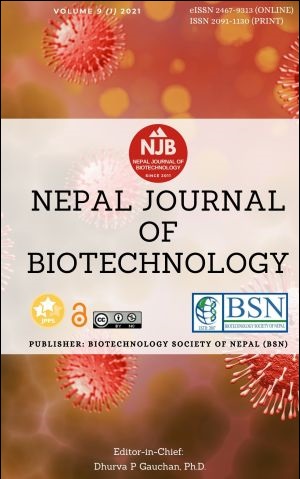Comparative Study of Nutritional Profile of Rice Varieties in Nepal
DOI:
https://doi.org/10.3126/njb.v9i1.38648Keywords:
Pigmented Rice, Antioxidant, phytochemicals, Jumli MarsiAbstract
The purpose of this study was to evaluate and compare the nutritional quality of different rice varieties (Taichung-176, Khumal-4 rice, and Black rice) with Jumli Marsi rice. The highest nutritional factors and phytochemical components were found in the Marsi rice (RR) and Black rice (BR). The highest amount of antioxidant property and phenolic content was found in Black rice which was 61.58 ± 0.02% and 22.75 ± 0.02GAE/100g respectively. The reducing sugar was found to be highest in the TR rice variety, which was 2.74±0.01%. The results also highlight the cooking and physicochemical properties of rice depending on the amylose content of rice varieties. The qualitative analysis of the phytochemical content in different rice varieties showed the presence of tannin, flavonoid, alkaloid, and terpenoid in Marsi and BR. While anthraquinone and saponin were negative for all the rice varieties, protein and glycoside were found to be present in all the rice varieties. Also, the pigmented rice varieties were found to have high nutritional components compared to the non-pigmented rice varieties. All the data observed in the study was found to be statistically significant (p < 0.05).
Downloads
Downloads
Published
How to Cite
Issue
Section
License
Copyright (c) 2021 Biotechnology Society of Nepal

This work is licensed under a Creative Commons Attribution-NonCommercial 4.0 International License.
Copyright Notice:
The manuscript submitted to NJB must be an original contribution, not previously published and should not be under consideration for publication elsewhere. When the manuscript is accepted for publication, the authors agree to automatically transfer the copyright of the article to the publisher. It should grant permission to any third party, in advance and in perpetuity, the right to use, reproduce or disseminate your article, according to the NJB copyright and license agreement.
Authors transfer copyright to the publisher as part of a journal publishing agreement but have the rights to: Share their article for Personal Use, Internal Institutional Use and Scholarly Sharing purposes, with the NJB applies the Creative Commons Attribution-NonCommercial CC BY-NC license to all the works we publish after Jun 2020 (Before it was CC BY-NC-ND). Under this license, authors agree to make articles legally available for reuse, without permission or fees, for virtually any non-commercial purpose. Anyone may remix, adapt, and build upon your work non-commercially, and although their new works must also acknowledge you and be non-commercial, they don’t have to license their derivative works on the same terms. More details on CC BY-NC refer to its Licence Deed and Legal Code.






